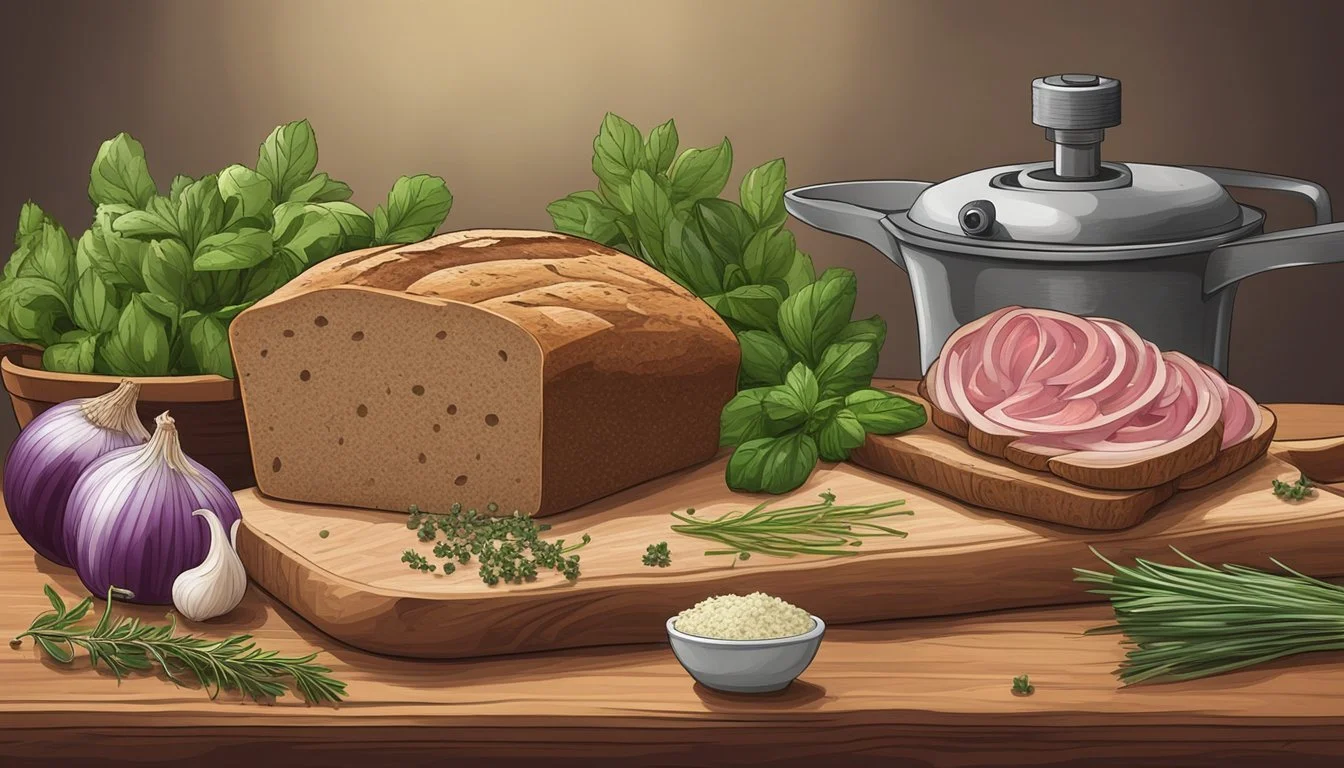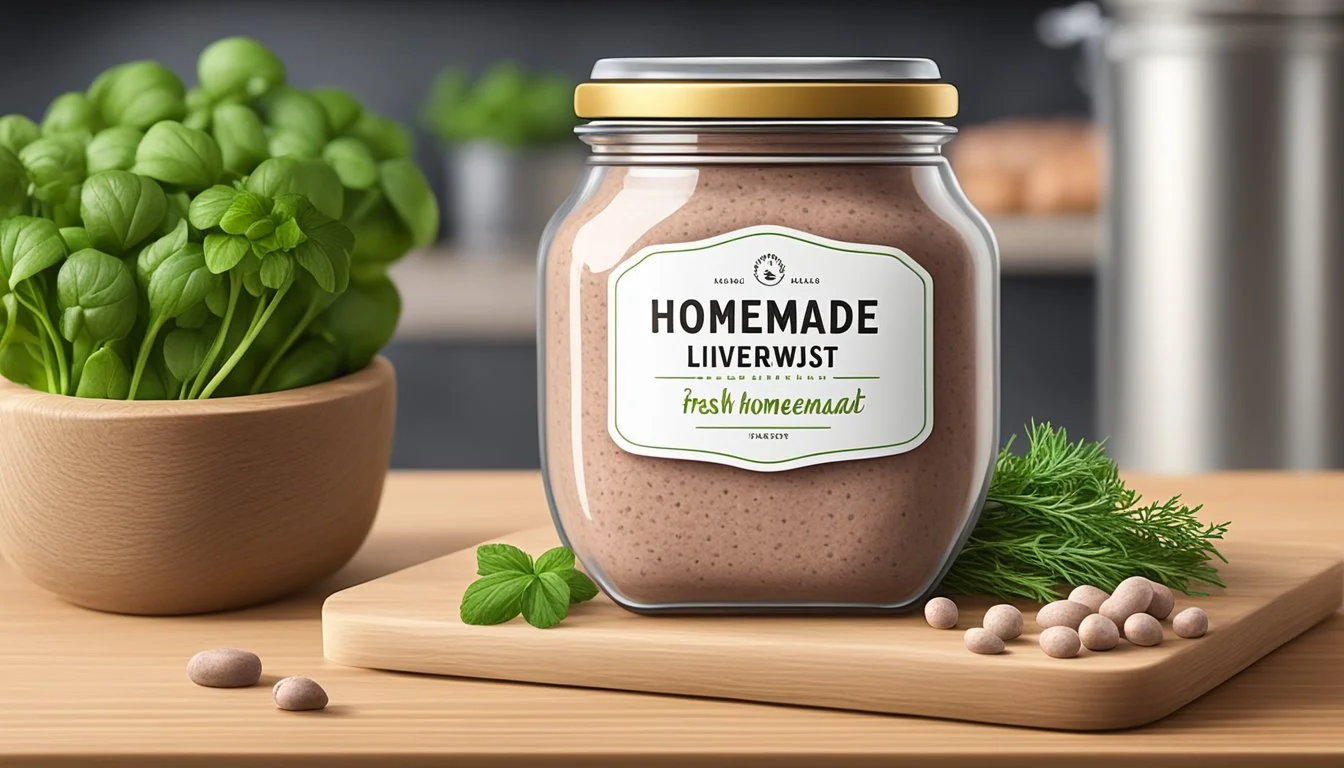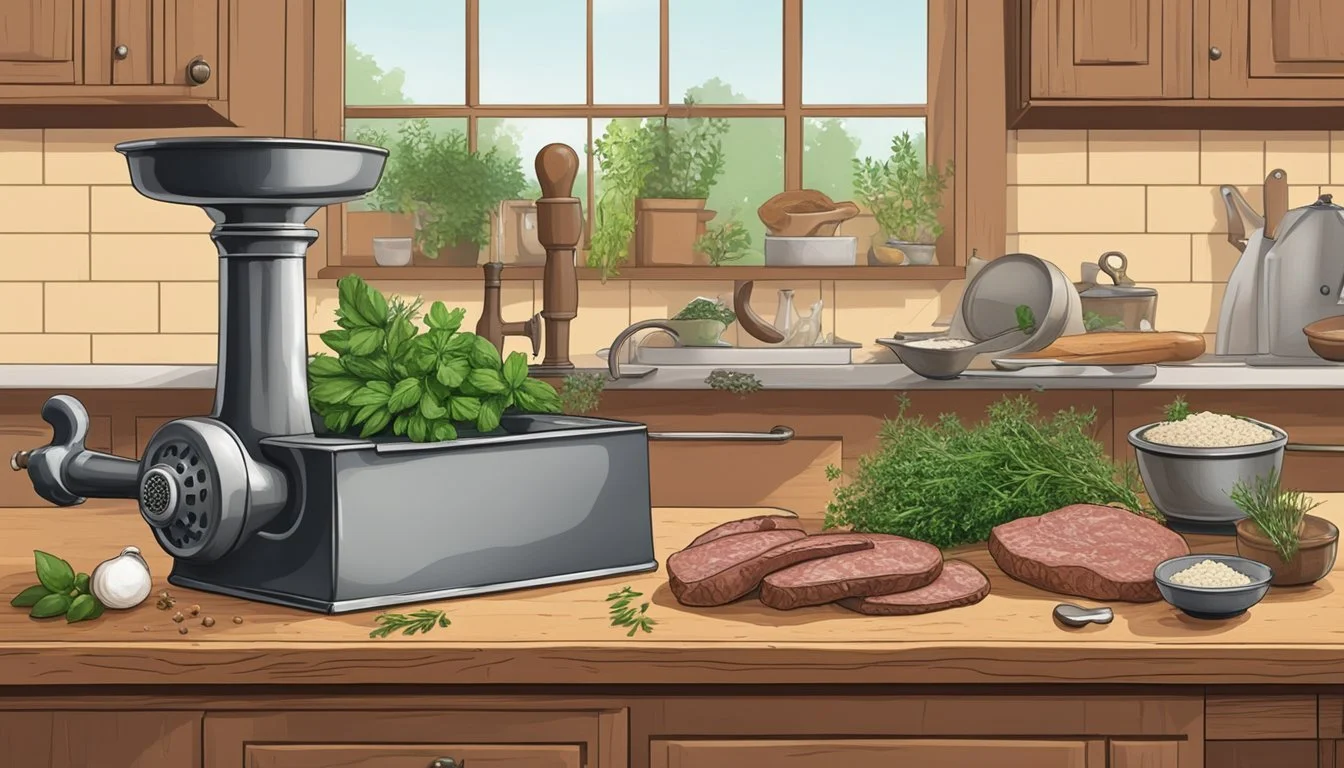Homemade Liverwurst
A Step-by-Step Guide to Crafting Deli Classics at Home
Liverwurst, a traditional delicacy in German cuisine, is a type of sausage made primarily from liver and other meats. Its rich flavor and creamy texture make it a popular spread for sandwiches and a flavorful component of charcuterie (What wine goes well with charcuterie?) boards. While commonly found in European delis, making liverwurst at home allows for personalized seasoning and ensures the freshness of ingredients, offering a rewarding culinary experience.
Crafting homemade liverwurst begins with selecting quality meats such as pork belly, and combining them with aromatic spices and herbs. The process involves cooking the meats with seasonings, and then grinding them to achieve the characteristic smooth consistency. Liverwurst can be cooked in a variety of ways, often encased in sausage skins and poached to perfection, providing a savory treat that can be enjoyed in multiple dishes ranging from simple snacks to elaborate feasts.
The practice of making liverwurst at home not only preserves traditional cooking methods but also allows for versatility in recipes. By controlling the ingredients, individuals can adjust the flavors to their preference, from mild to robust, and can ensure that their liverwurst is free from additives found in some commercial options. The end result is a homemade liverwurst that enriches any home deli with its depth of flavor and homemade quality.
Understanding Liverwurst
Liverwurst, a traditional delicacy, has a rich history and comes in various forms to satisfy diverse tastes.
Historical Background
Liverwurst, or Leberwurst as it's known in its native German, refers to a type of sausage where the liver is a primary ingredient. It emerged out of necessity to use all parts of butchered animals and has since become a staple in German cuisine. Variants of liverwurst can be traced back centuries, with recipes evolving over time to include a variety of spices and ingredients.
Liverwurst Varieties
The most common varieties of liverwurst include:
Classic German Liverwurst: A fine mixture characterized by its smooth texture and rich flavor.
Braunschweiger: A type of liverwurst that is smoked after packaging, adding a unique depth to its taste.
Liver sausage comes in multiple forms, often categorized by texture:
Fine or spreadable: Suited for spreading on bread or crackers.
Coarse: Contains chunks of liver or meat, offering a more rustic experience.
Liverwurst is traditionally made using pork, although variations using other meats such as lamb also exist. The mixture typically includes ingredients such as onions, salt, and a blend of spices tailored to create distinctive regional flavors. Recipes may differ, but the essential process involves cooking the meat and liver, grinding, and then encasing the mixture, with some types like Braunschweiger undergoing additional smoking.
Nutritional Profile
Homemade liverwurst is a rich source of nutrients essential for a healthy diet, although it can be high in calories and fat. It is important to consider its nutritional makeup when incorporating it into your meal planning.
Caloric Content
Liverwurst typically contains a significant amount of calories due to its meat and fat content. A standard serving of liverwurst can vary in calorie count depending on the specific recipe and portion size but generally ranges between 200-300 calories per serving.
Vitamins and Minerals
Liverwurst is a good source of several key vitamins and minerals:
Vitamin C: Vital for immune system function.
Calcium: Important for bone health.
Potassium: Helps regulate blood pressure and is critical for heart health.
Iron: Essential for blood cell production.
This food also contains meaningful levels of:
Cholesterol: Necessary in moderation for various bodily functions.
Sodium: Often present in notable amounts, which influences blood pressure.
Macronutrient Breakdown
Liverwurst's macronutrient profile generally includes a combination of proteins, fats, and a minimal amount of carbohydrates:
Protein: Provides about 14-20 grams per serving, crucial for muscle maintenance and growth.
Saturated fat: The content will vary with ingredients, but liverwurst can be high in saturated fats.
Total Fat: Each serving generally contains a considerable amount of fat, ranging from 15-25 grams, with the majority being saturated.
Key Ingredients
Creating a flavorful homemade liverwurst begins with selecting quality ingredients. Each component, from the liver to the spices, plays a crucial role in developing the taste and texture of this traditional deli treat.
Selecting the Liver
The choice of liver is the foundation of any liverwurst recipe. The most common options include pork liver, which offers a classic taste, and beef liver, known for its robust flavor. Calf liver provides a milder and more refined taste, while poultry liver, such as chicken or turkey, delivers a lighter version of liverwurst. It's essential for the liver to be fresh to ensure the best flavor and texture in the final product.
The Role of Spices
Spices are pivotal in enhancing and complementing the rich flavor of the liver. Traditional liverwurst often contains:
Salt: A critical seasoning that amplifies the natural taste of the ingredients. Kosher salt is a popular choice due to its pure flavor.
White Pepper: Adds a piquant note without overpowering the liver.
Allspice: Contributes a warm, aromatic depth to the meat mixture.
Nutmeg and Ginger: Both spices offer a sweet and slightly spicy undertone.
Sage and Marjoram: These herbs, whether used fresh or dried marjoram, provide a savory and earthy layer to the liverwurst's profile.
When using spices and herbs, balancing flavors to suit personal preferences while maintaining the integrity of the classic liverwurst taste is important.
Additional Components
Apart from liver and spices, other ingredients are necessary to achieve the desired consistency and flavor:
Onion: Normally sautéed until soft, it imparts sweetness and complexity.
Fat: An important part of the recipe, where pork belly or bacon is often used to add both texture and rich taste.
Liquid: Water, or in some recipes, brandy, is used to cook the liver and spices, marrying the flavors together.
While optional, some recipes call for additional elements like marjoram or creamy agents to enhance mouthfeel and create a smooth paste more conducive to the characteristic spreadable nature of liverwurst.
By focusing on the right mix of key ingredients, one can craft a truly authentic and delectable liverwurst that rivals those found in European delicatessens.
Preparation Essentials
Creating homemade liverwurst requires meticulous preparation and specific equipment. Attention to detail in the prep stage as well as during the grinding process ensures a successful loaf.
Required Equipment
To begin, chefs need:
Large Pot: For simmering ingredients.
Meat Grinder: For processing liver and pork belly.
Food Processor: An alternative to a meat grinder for blending meat.
Loaf Pan: To shape the liverwurst during cooking.
Thermometer: Essential for monitoring the internal temperature.
Knife: A sharp knife is required to properly prep the ingredients.
Ahead of Time: Prepping the Ingredients
Prior to cooking, they must:
Quarter a large white onion: Using a knife for even pieces.
Prepare Seasonings: Measure out all spices for consistency.
Chill Meat: Refrigerate the pork belly and liver to firm it up, making it easier to grind.
Grinding and Blending Techniques
When ready to grind:
Ensure Equipment is Cold: Cold equipment prevents fat smearing.
Grind Liver: Pass liver through the meat grinder for a fine consistency.
Blend Until Smooth: If using a food processor, blend until the mixture is homogenous with no large chunks remaining.
Mixing Seasonings: Integrate the spices evenly throughout the meat blend before cooking.
Cooking Process
Making homemade liverwurst involves meticulous preparation and cooking methods to create a flavorful delicacy. The process from stuffing to testing for doneness is both an art and a science, requiring precise temperatures and techniques.
Stuffing and Shaping
Before one begins the stuffing process, the liverwurst mixture needs to be finely ground and well mixed. Stuffing the mixture into natural casings can be done using a sausage stuffer. It’s essential to ensure there are no air pockets as they shape their liverwurst; this prevents potential ruptures during cooking.
Cooking Methods Explored
The liverwurst is typically cooked in a water bath or via sous vide to ensure even cooking. For the water bath method, the liverwurst is submerged in boiling water and cooked at a steady boil. Conversely, sous vide involves sealing the liverwurst, either within its casing or a vacuum seal, and cooking it in water held at a precise temperature for several hours.
Achieving the Ideal Texture
The key to the perfect texture is maintaining a consistent internal temperature and avoiding overcooking. In a water bath, the liverwurst should be kept below the boiling point to prevent the casing from bursting. For sous vide, the temperature is typically set around 150°F to 160°F (65°C to 71°C), ensuring the liverwurst cooks gently and retains moisture.
Testing for Doneness
One ascertains doneness by measuring the internal temperature of the liverwurst, which should reach 160°F (71°C). They can use a meat thermometer for accuracy. After cooking, placing the liverwurst in an ice water bath stops the cooking process immediately and helps in firming up the sausage. Once cooled, the liverwurst can be taken out of the water, dried, and then chilled until it's ready to be sliced and served.
Liverwurst Storage Tips
Properly storing liverwurst is crucial for maintaining its freshness and preventing foodborne illnesses. The following storage methods will ensure that your homemade liverwurst remains delicious and safe to eat.
Short-Term Refrigeration
To store liverwurst in the refrigerator for short-term use, one should place it in an airtight container to prevent it from picking up flavors from other foods and to avoid dehydration. A mason jar or plastic container with a tight-fitting lid works well. Liverwurst can be refrigerated for up to two weeks.
Container Type: Airtight (e.g., mason jars, Tupperware)
Duration: Up to two weeks
Temperature: 35-40°F (1.7-4.4°C)
Long-Term Freezing
For long-term storage, liverwurst should be frozen. Using a vacuum-sealed bag is recommended to prevent freezer burn and dehydration. If a vacuum sealer is not available, wrapping the liverwurst in cling film and then in aluminum foil can be an effective alternative. Liverwurst can be frozen for up to three months for optimal taste, although it remains safe to eat beyond this time frame.
Method: Vacuum sealing preferred, or tightly wrapped
Duration: Up to three months for best quality
Freezing Point: 0°F (-18°C) or below
Shelf Life and Safety
The shelf life of liverwurst depends on the chosen storage method. When keeping the product in the refrigerator or freezer, it's important to label it with the date of storage to keep track of its age. One should always inspect the liverwurst for signs of spoilage—such as an off odor, discoloration, or slimy texture—before consumption.
Refrigerated Shelf Life: Up to two weeks
Frozen Shelf Life: Up to three months (best quality)
Signs of Spoilage: Off odor, discoloration, sliminess
Serving and Enjoyment
Once the homemade liverwurst is prepared and ready, it can be served in a variety of ways that enhance its rich flavor. This section offers traditional methods, imaginative variations, and pairing suggestions to elevate the liverwurst experience.
Traditional Serving Methods
Liverwurst serves as a cornerstone in charcuterie boards and sandwiches. Traditionally, it’s sliced and spread on crusty bread or crackers. Caramelized onions, either white or red, make for a particularly delicious addition, bringing out the subtle spices of the liverwurst. For those who enjoy a bit more zest, a dollop of mustard or a pat of butter can complement the liverwurst’s robust flavor.
Creative Recipe Variations
Liverwurst is versatile and benefits from creative culinary experimentation. One might incorporate it into a spread by mixing it with cream cheese, milk powder, and herbs for a richer texture. Alternatively, integrating tiny bits of bacon or infusing the mixture with a hint of brandy can offer a unique twist to the traditional recipe. These variations cater to different flavor profiles while honoring the essence of the classic liverwurst.
Pairing Ideas
When thinking of pairings, balance is key. Robust liverwurst harmonizes well with slightly acidic or sweet elements, like pickles or chutney. It can also be served alongside a variety of cheeses within a charcuterie spread. To complement the rich flavor of liverwurst, one might choose beverages like a crisp lager or a full-bodied red wine that can stand up to the hearty nature of this deli staple.
Advanced Liverwurst Making
In this section, dedicated home chefs can take their charcuterie skills to new heights by learning specialized techniques that go beyond the basics of liverwurst preparation.
Delving into Charcuterie
Making liverwurst can be an entry into the broader world of charcuterie, particularly when exploring more advanced preparations such as terrines and smoked varieties. A terrine can provide an elegant presentation of liverwurst, often involving a layered assembly that is then cooked in a water bath. On the other hand, adding a smoked element can impart depth and complexity to the flavor profile. Achieving a successful smoked liverwurst involves precise control over temperature and smoke quality. The smoking process requires a dedicated smoker or a modified grill to maintain a steady flow of smoke and an even temperature.
Specialized Techniques
To achieve a quality akin to commercial liverwurst, certain specialized techniques and equipment may be employed:
Meat grinding: For a smoother texture, it is advisable to grind the cooked liver multiple times. A commercial-grade stand mixer with a grinding attachment makes this process more efficient.
Emulsification: Liverwurst is essentially an emulsion of meat, fat, and liquid. Achieving a stable emulsion can be the difference between professional and amateur results. This can be done in a food processor or with a high-powered blender for smaller batches.
Braunschweiger: This variant of liverwurst includes raw liver and is typically smoked. Advanced makers often experiment with creating their own versions of Braunschweiger, incorporating a smoky flavor into the blend.
By integrating these advanced techniques, one elevates the simple liverwurst to a delicatessen-worthy item, showcasing the artistry of charcuterie at home.
Additional Information
This section provides a structured approach to ensure a smooth liverwurst preparation. It includes a breakdown of the process timeline, insights on how to address common issues, and answers to pertinent questions about making liverwurst.
Recipe Timeline
Prep Time: Generally, it takes about 30 minutes to prepare the ingredients for liverwurst. This includes cutting the onions, portioning the meat, and assembling spices.
Cook Time: Cooking and simmering the ingredients typically requires about 2 hours to ensure that the meat is tender and flavors are well incorporated.
Total Time: From preparation to completion, the total time for crafting homemade liverwurst is approximately 2 hours and 30 minutes, although additional chilling time can extend this duration.
Yield: A standard recipe yields approximately 2-3 pounds of liverwurst.
Troubleshooting Common Issues
Texture Problems:
Grinding meat too finely or not enough can affect texture. It should be uniform and spreadable. Adjust the grinding process as needed.
Flavor Imbalance:
Excessive seasoning might overpower the meat's flavor. Always start with smaller amounts of spices and adjust to taste after mixing.
Cooking Mishaps:
Meat not fully cooked? Extend the simmering time. Always confirm by checking the internal temperature reaches 160°F (71°C).
Frequently Asked Questions
What if the liverwurst is too dry?
Add more fat or consider a bit of liquid like broth to moisten the mixture before the final grind.
Can I substitute ingredients?
Yes, substitutions like using different types of liver or onion varieties are common, but they may alter the final taste slightly.
How long does homemade liverwurst last in the refrigerator?
Properly sealed, it can last up to 7 days in the refrigerator. For longer storage, it can be frozen for up to 3 months.
Is there a way to reduce prep time?
Prep time can be minimized by organizing and measuring all ingredients beforehand and using pre-ground spices when feasible.







